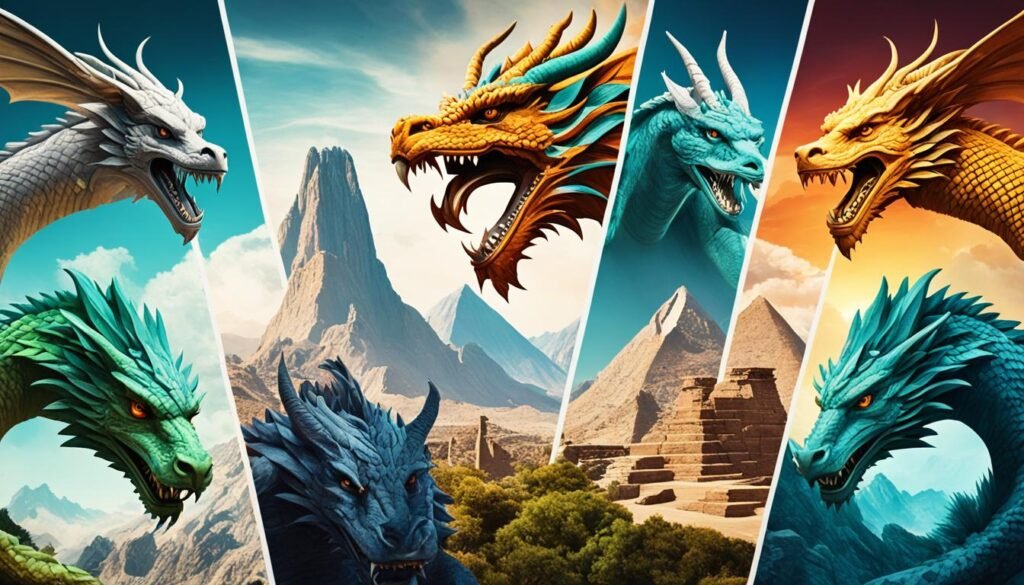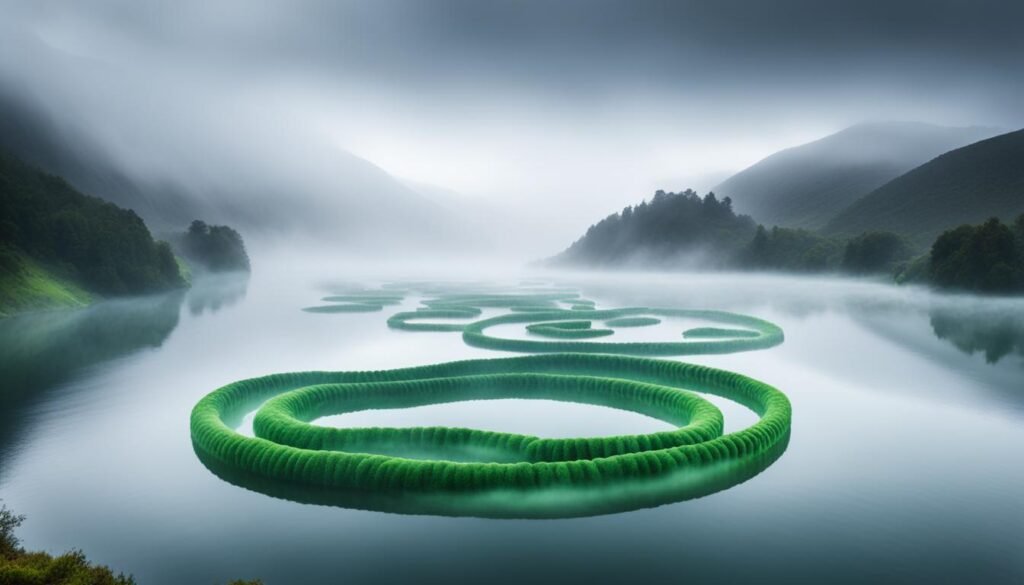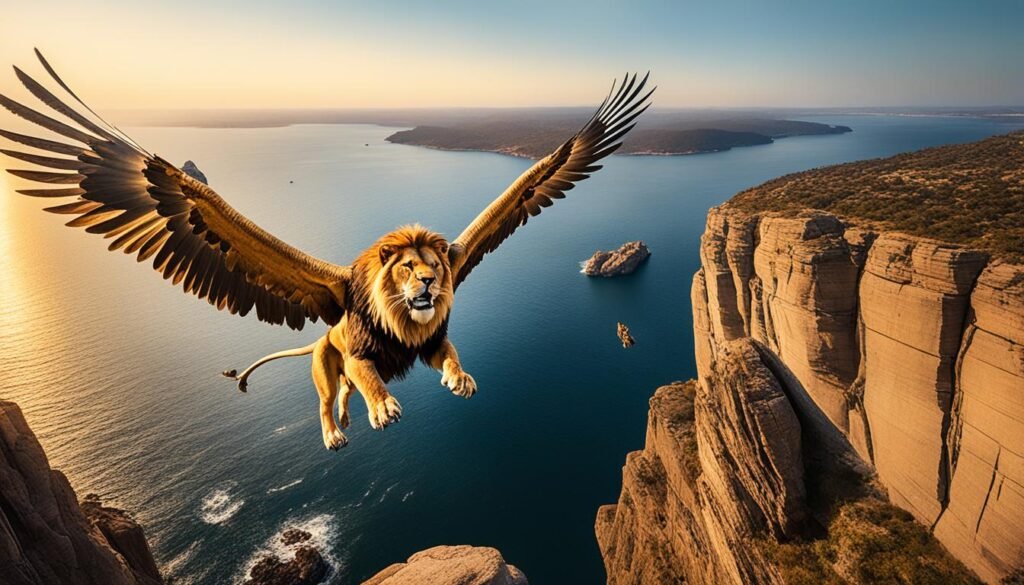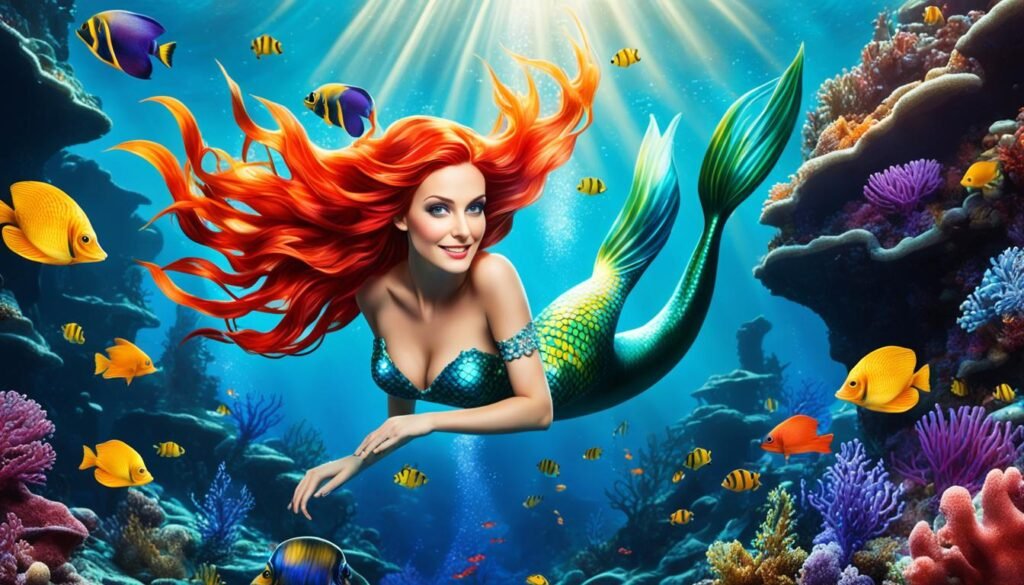Mythical creatures have been a significant part of mythology worldwide. These creatures, often depicted as legendary beings, hold a special place in ancient tales and folklore across various cultures. From Greek mythology to Celtic folklore, these mythical creatures continue to captivate the imaginations of people throughout history.
Key Takeaways : Mythical Creatures in Mythology
- Mythical creatures have played a significant role in mythology and folklore worldwide.
- These creatures are often depicted as legendary beings and have captivated the imaginations of people throughout history.
- From Greek mythology to Celtic folklore, cultures worldwide have their own unique mythical creatures.
- Exploring these creatures provides a deeper understanding of ancient tales and cultures.
- Mythical creatures continue to fascinate and enchant people today, fueling our fascination with mythology and folklore.
Mythical Creatures in Celtic Mythology
Celtic mythology is a treasure trove of enchanting creatures that have captivated imaginations for centuries. These mythological beings embody the deep connection the Celtic people had with nature and the spirit world. Immerse yourself in the rich tapestry of Celtic mythological creatures, each one more fascinating than the last.
Selkies
Selkies are shape-shifting beings associated with love and the sea. According to Celtic folklore, they are seals that can shed their skin to transform into beautiful humans. Selkies are believed to possess great singing voices and are known to captivate both sailors and land-dwellers. These enchanting creatures symbolize the delicate balance between humanity and the untamed power of the ocean.
Banshees
Banshees are female spirits with a haunting presence and wailing cries. In Celtic mythology, they are said to foretell death in families, appearing as a harbinger of the imminent passing of a loved one. Banshees are often portrayed as shrouded figures with long, flowing hair. Their mournful cries echo through the night, sending chills down the spines of those who encounter them.
Pooka
Pooka is a mischievous creature that challenges humans to confront their fears. In Celtic folklore, Pookas often take the form of black horses, but they can also transform into various other animals. They delight in playing tricks on unsuspecting individuals, leading them on wild journeys and testing their resilience. Pookas symbolize the need to embrace one’s inner courage and overcome challenges.
Puca
Puca is another shape-shifting spirit found in Celtic mythology. These mischievous beings appear as different animals, such as horses, hares, or goats. Puca are known for their unpredictability and can bring good or bad fortune to those they encounter. They often blur the line between the mortal world and the supernatural, reminding humans of the mystical aspects of life.
These captivating Celtic mythological creatures are just a glimpse into the rich tapestry of enchantment and wonder that Celtic mythology offers. Immerse yourself in the tales of selkies, banshees, Pookas, and Puca, and let your imagination soar in the realms of these extraordinary beings.

Mythical Creatures from Around the World
Mythical creatures can be found in various cultures worldwide, each with its own unique supernatural beings, mythological creatures, and folklore monsters. These creatures add depth and enchantment to the myths and legends of different cultures.
From buckriders in Belgium and the Netherlands, who are said to ride winged goats through the air, to Valkyries in Norse mythology, warrior women choosing who lives and dies on the battlefield, the world is filled with mythical creatures waiting to be explored.
Let’s take a closer look at some of these fascinating beings:
Belgian and Dutch Mythology: Buckriders
In the folklore of Belgium and the Netherlands, buckriders are supernatural creatures known for their ability to ride through the night sky on the backs of winged goats. These mysterious beings, often depicted as ghostly figures, were believed to be members of secret cults. According to legend, buckriders would gather at night for wild rides, terrorizing the local communities.
Norse Mythology: Valkyries
In Norse mythology, Valkyries are powerful female figures who serve as Odin’s handmaidens. These warrior women have the task of choosing who lives and dies on the battlefield, guiding the souls of fallen warriors to either Valhalla or Fólkvangr. Valkyries are often depicted as fierce and noble, with a deep connection to both life and death.
Greek Mythology: Centaurs
In Greek mythology, centaurs were creatures with the upper body of a human and the lower body of a horse. These mythical beings were known for their wild and untamed nature, often associated with both drunkenness and wisdom. Centaurs played a significant role in various myths and legends, including the well-known story of Hercules.
| Mythology | Mythical Creature | Description |
|---|---|---|
| Egyptian | Sphinx | A mystical creature with the body of a lion and the head of a human or animal. Sphinxes were often depicted as guardians and enigmas of wisdom. |
| Japanese | Kitsune | A shapeshifting fox spirit that possesses intelligence and magical abilities. Kitsune are often portrayed as mischievous tricksters. |
| Australian Aboriginal | Bunyip | A water spirit from Aboriginal folklore, often described as a large creature inhabiting rivers and swamps. The Bunyip is known for its mysterious and elusive nature. |
These are just a few examples of the vast array of mythical creatures found in cultures around the world. From ancient legends to modern folklore, these supernatural beings continue to captivate our imaginations and remind us of the rich diversity of human storytelling.
The Loch Ness Monster in Scottish Folklore
The Loch Ness Monster, also known as Nessie, is a legendary creature deeply ingrained in Scottish folklore. According to popular belief, this mysterious creature has been lurking in the depths of Loch Ness, a large freshwater loch located in the Scottish Highlands, for centuries. Its elusive nature and the compelling tales surrounding it have made the Loch Ness Monster one of the most fascinating legendary creatures in the world.
Legends of the Loch Ness Monster date back to ancient times, with accounts of sightings and encounters captivating the minds of locals and visitors alike. However, it was in 1934 that the creature gained international attention when the so-called “Surgeon’s Photo” was published in the Daily Mail. The photograph depicted a humped figure emerging from the waters of Loch Ness, becoming an iconic image associated with the Loch Ness Monster.
To this day, the Loch Ness Monster continues to captivate the curiosity of believers and skeptics worldwide. The legend has become a significant part of Scottish identity and has contributed to the tourism industry in the region. Every year, thousands of tourists visit Loch Ness, hoping to catch a glimpse of this elusive creature.
“The Loch Ness Monster is a testament to the enduring power of myths and legends, sparking imagination and wonder in people of all ages.” – Dr. Emily Wilson, Folklore Expert
While skeptics argue that the Loch Ness Monster is merely a product of folklore and hoaxes, the allure of this legendary creature remains strong. Whether it is a remnant of prehistoric times or a figment of collective imagination, the mystery surrounding the Loch Ness Monster continues to fascinate and inspire exploration. It is a testament to the power of myths and legends and their ability to ignite our sense of wonder and curiosity about the unknown.
Theories and Interpretations
Over the years, numerous theories have been proposed to explain the existence of the Loch Ness Monster. Some suggest that it could be a surviving plesiosaur, a type of marine reptile that lived millions of years ago. Others believe it could be a large unidentified fish, such as a giant eel or catfish.
Despite extensive scientific studies and investigations, conclusive evidence of the Loch Ness Monster’s existence remains elusive. Nevertheless, the legend lives on, and the Loch Ness Monster continues to capture the imagination of believers, fueling ongoing research and exploration of the mysterious depths of Loch Ness.
| Interesting Facts about the Loch Ness Monster |
|---|
| The first reported sighting of the Loch Ness Monster dates back to the 6th century when an Irish monk allegedly encountered a “water beast” in the Loch. |
| Since the famous “Surgeon’s Photo,” numerous other photographs, videos, and sonar readings have claimed to capture evidence of the Loch Ness Monster, but their authenticity remains disputed. |
| In addition to the Loch Ness Monster, several other lake monsters and cryptids exist in folklore and legends around the world, such as Champ in Lake Champlain and Ogopogo in Lake Okanagan. |
| The annual Loch Ness Monster Day is celebrated on April 21st, commemorating the legend and promoting tourism in the area. |
| While there is no concrete scientific proof of the Loch Ness Monster, the legend has had a significant impact on the local economy, attracting tourists and enthusiasts from around the world. |
Exploring Chinese Mythology and Mythical Creatures
Chinese mythology is a treasure trove of captivating stories and legendary creatures that have become iconic symbols in Chinese culture. From majestic dragons to mystical phoenixes and auspicious qilin, these mythical beings hold a significant place in Chinese folklore and art.
The dragon, known as the Long in Chinese mythology, is one of the most revered creatures. It represents power, wisdom, and good fortune. Dragons are believed to control the weather and bring rain for a bountiful harvest. They are often depicted as long, serpentine creatures with dragon scales and sharp claws.
The phoenix, also known as Fenghuang, is a mythical bird associated with prosperity, beauty, and rebirth. It is a symbol of grace and high virtue. The phoenix is often portrayed with vibrant feathers in radiant colors and is believed to appear during times of peace and prosperity.
The qilin, also spelled as kirin, is a mythical creature that is associated with luck, good omens, and protection. It has the body of a deer, the tail of an ox, and the hooves of a horse. Qilin is often depicted as a gentle creature with mythical attributes.
These mythical creatures are not only found in ancient folklore but also play an essential role in Chinese art and architecture. Detailed carvings and intricate paintings showcase the grandeur and significance of these creatures in Chinese culture.
Chinese mythology also includes tales of immortals and other supernatural beings. Immortals, known as Xian in Chinese, are revered for their extraordinary powers and longevity. They are often depicted as wise, benevolent individuals who have achieved immortality through enlightenment and cultivation.
The Symbolism of Chinese Mythical Creatures
Each mythical creature in Chinese folklore holds symbolic meaning and represents different aspects of Chinese culture and values. The dragon symbolizes power, strength, and imperial authority. It is closely associated with the Emperor and has been the national emblem of China for thousands of years.
The phoenix represents feminine power, virtue, and grace. It is often associated with the Empress and represents the yin energy, complementing the dragon’s yang energy. Together, they symbolize the harmonious balance of power and grace.
The qilin symbolizes prosperity, harmony, and protection. It is often considered a good omen and is believed to bring blessings and ward off evil spirits.
The iconic nature of Chinese mythology and its mythical creatures has influenced various aspects of Chinese culture, including art, literature, and even popular culture. The allure and symbolism of these creatures continue to fascinate people worldwide.
Chinese Mythical Creatures in Popular Culture
The influence of Chinese mythical creatures extends beyond ancient legends and folklore. They have found their way into popular culture, both in China and around the world. From movies like “Crouching Tiger, Hidden Dragon” to video games like “League of Legends,” these creatures are celebrated and recognized for their awe-inspiring presence.
Table: Chinese Mythical Creatures and Their Symbolism
| Mythical Creature | Symbolism |
|---|---|
| Dragon (Long) | Power, wisdom, good fortune |
| Phoenix (Fenghuang) | Prosperity, beauty, rebirth |
| Qilin (Kirin) | Luck, good omens, protection |
As we delve into the world of Chinese mythology and explore the stories of these mythical creatures, we uncover a rich tapestry of symbolism, cultural significance, and timeless narratives. These creatures continue to inspire and ignite our imagination, reminding us of the profound connection between mythology, culture, and human storytelling.
The Intriguing World of Greek Mythological Creatures
Greek mythology is renowned for its vast array of captivating creatures and monsters. These legendary beings and mythical beasts have left an indelible mark on ancient Greek culture and continue to capture the imaginations of people today. From ferocious monsters to majestic beasts, the world of Greek mythological creatures is a fascinating realm to explore.
“Greek mythology is a treasure trove of incredible creatures that bring the ancient tales to life.”
The Hydra: A Terrifying Serpent-Like Monster
The Hydra is a fearsome creature from Greek mythology. This venomous serpent possesses multiple heads, often depicted as nine or more, and was known for its ability to grow two heads in place of one if any were cut off. The Hydra’s venom was so potent that it could corrode anything it touched, making it a formidable opponent for any hero or adventurer.
The Minotaur: Half-Human, Half-Bull
The Minotaur is another iconic creature from Greek mythology. Born from the unnatural union of Queen Pasiphae and a bull, the Minotaur possessed the head and tail of a bull but the body of a man. Imprisoned within the labyrinth of Knossos, the Minotaur posed a significant threat to all who entered its maze.
Medusa: The Serpentine Gorgon with Petrifying Gaze
Medusa, one of the Gorgons, was a monstrous creature with snakes for hair and a gaze that could turn anyone to stone. Slain by the hero Perseus, the head of Medusa became a powerful weapon and a symbol of protection in Greek mythology.
“The tales of Greek mythological creatures continue to fascinate and inspire artists, writers, and storytellers across the globe.”
Here is a table showcasing some of the most notable Greek mythological creatures:
| Creature | Description |
|---|---|
| Hydra | A multi-headed serpent with deadly venom. |
| Minotaur | A half-human, half-bull creature trapped in a labyrinth. |
| Medusa | A snake-haired Gorgon with a petrifying gaze. |
| Centaur | A creature with the upper body of a human and the lower body of a horse. |
| Phoenix | A magnificent bird that is reborn from its ashes. |
The world of Greek mythological creatures is filled with wonders and terrors, each with its own unique story and significance. These legendary monsters and mythical beasts have shaped the narratives of ancient Greece and continue to be a source of intrigue, inspiring countless works of art, literature, and popular culture.
Mythical Creatures in Haitian Folklore
Haitian folklore is a treasure trove of supernatural creatures and mythical beings that are deeply ingrained in the country’s vibrant culture and rich traditions. These mystical entities, often believed to possess magical powers, are said to inhabit the natural world, bridging the gap between reality and the spirit realm.
One fascinating creature in Haitian folklore is the Loup Garou, a hairy humanoid beast that roams the night. Legends describe the Loup Garou as a shapeshifter who can take the form of a wolf or a werewolf-like creature with immense strength. It is believed that individuals can become a Loup Garou through a curse or as a result of dark magic.
Another intriguing figure in Haitian mythology is the Lutin, a mischievous and cunning supernatural being. Lutins are known for their shape-shifting abilities, often taking the form of animals or objects to play pranks on unsuspecting humans. They are said to possess a mischievous nature and enjoy causing chaos and confusion in the lives of those they encounter.
| Supernatural Creature | Description |
|---|---|
| Loup Garou | A hairy humanoid creature with shapeshifting abilities, often appearing as a wolf or a werewolf-like beast. |
| Lutin | A mischievous and cunning shape-shifting being known for playing pranks on humans. |
| Moko Jumbie | Tall, stilt-walking spirits believed to bring protection and ward off evil. |
| Zombi | A reanimated corpse brought back to life through dark magic, often under the control of a sorcerer. |
In addition to the Loup Garou and the Lutin, Haitian folklore also features other mystical beings such as the Moko Jumbie, tall stilt-walking spirits who are believed to offer protection and ward off evil. These enchanting creatures are often seen during carnival celebrations and play a significant role in Haitian cultural festivals.
The Zombi, a reanimated corpse brought back to life through dark magic, is another well-known figure in Haitian mythology. Zombis are often depicted as mindless beings under the control of a sorcerer, forced to serve their master’s every command. The concept of the Zombi has gained international recognition and has been popularized in various forms of media.
Haitian folklore offers a fascinating glimpse into a world of supernatural creatures and mythical beings that are a vital part of the country’s cultural fabric. These extraordinary entities continue to captivate the imagination and spark an enduring fascination, connecting people to the mystical and mysterious aspects of the human experience.
The Fascinating World of Mermaids and Other Water Creatures
The allure of mermaids and other water creatures has captured the imaginations of people around the world. Found in various mythologies and folklore, these mythical beings are often portrayed as beautiful women with fish-like tails. From the sirens of Greek mythology to the mermaids of European folklore, these creatures have fascinated and intrigued people for centuries.
Mermaids in Greek Mythology
In Greek mythology, mermaids, known as sirens, were enchanting creatures with the upper body of a woman and the tail of a fish. They possessed irresistible singing voices that lured sailors to their demise, beckoning them towards treacherous rocks and dangerous waters.
Mermaids in European Folklore
In European folklore, mermaids were often depicted as benevolent beings who would appear to sailors in times of danger, offering guidance and protection. Tales of mermaids combing their long hair with golden combs, sitting on rocks, and singing melodious songs have been passed down through generations.
“The ocean’s depths concealed a world of wonder, where mermaids danced beneath the waves, luring sailors with their enchanting songs.” – Unknown
Legends of mermaids traversing the open seas, basking in sunlight, and gracefully swimming through the water have become deeply ingrained in maritime cultures throughout history.
Other Water Creatures and Sea Monsters
Alongside mermaids, mythology and folklore are replete with a diverse array of other water creatures and sea monsters. From the scaly-wrapped Leviathan to the fearsome Kraken and the serpentine Loch Ness Monster, these mythical beings embody the mysteries and dangers that lie beneath the ocean’s surface.
Whether they were believed to protect treasures, cause storms with their anger, or guard mystical realms, these legendary creatures play a vital role in ancient tales and continue to captivate the imaginations of people to this day.
| Mythical Beings | Description |
|---|---|
| Mermaids | Beautiful beings with fish-like tails, often portrayed as enchanting sirens or helpful creatures in mythology and folklore. |
| Sirens | Irresistible singers in Greek mythology who lured sailors to their demise with their enchanting voices. |
| Leviathan | A monstrous sea creature often depicted as a scaled serpent-like being capable of causing great destruction. |
| Kraken | A legendary sea monster with immense size and strength, said to dwell in the depths of the ocean. |
| Loch Ness Monster | A cryptid creature rumored to inhabit Scotland’s Loch Ness, often described as a plesiosaur-like reptile. |
These mythical beings and sea creatures continue to inspire awe and curiosity, serving as a reminder of the vastness and mysteries of the world’s oceans.
Exploring the Realm of Magical Creatures in Literature and Pop Culture
Magical creatures have long been a beloved aspect of literature and popular culture. These fantastical beings bring a touch of enchantment to the stories we read and the movies we watch. From the pages of J.K. Rowling’s Harry Potter series to the vast world of J.R.R. Tolkien’s Middle-earth, magical creatures have captivated audiences with their extraordinary abilities and mythical allure.
In J.K. Rowling’s magical universe, we encounter a diverse array of magical creatures that inhabit the wizarding world. From the majestic and noble dragons to the majestic and phoenixes, these creatures add depth and wonder to Harry Potter’s journey. They serve as both allies and adversaries, embodying the rich tapestry of magical beings that populate Rowling’s extraordinary world.
J.R.R. Tolkien’s Middle-earth is also teeming with mythical creatures that ignite our imagination. From the wise and powerful dragons like Smaug to the gentle and mysterious ents, the land of Tolkien’s imagination is filled with legendary beasts. These creatures lend an air of majesty and danger to the epic tales set in Middle-earth.
“Fantasy is a necessary ingredient in living, it’s a way of looking at life through the wrong end of a telescope.” – Dr. Seuss
The presence of magical creatures extends beyond these iconic series. Throughout the vast landscape of fantasy literature, we encounter an abundance of creatures and beasts that evoke a sense of awe and wonder. From the noble and intelligent unicorns to the fearsome and monstrous wyverns, these mythical beings breathe life into the imaginative realms created by authors across genres and time periods.
In the realm of pop culture, magical creatures have become a phenomenon in their own right. From blockbuster movies to video games and merchandise, these fantastical beings have captured the hearts of fans around the world. They inspire cosplay, fan art, and endless discussions about their origins and powers.
As we delve into the fantastical realm of magical creatures in literature and popular culture, we unlock a world of limitless possibilities. These creatures ignite our imagination, allowing us to explore wondrous realms and embark on thrilling adventures. Whether we encounter them on the pages of a book or on the big screen, these legendary beasts continue to awe and inspire, reminding us of the powerful connection between storytelling, imagination, and our own desire for enchantment.
The Enduring Appeal of Mythical Creatures
Mythical creatures have an enduring appeal that spans across cultures and generations. These fascinating beings have captured the imagination of people throughout history, providing a sense of wonder and excitement. Whether it’s the majestic unicorns, fierce dragons, or mysterious mermaids, these mythical creatures have become iconic symbols that hold a special place in our collective imagination.
The enduring appeal of mythical creatures can be attributed to their association with fascination and intrigue. They embody the mysteries of the unknown, drawing us into the rich tapestry of mythology and folklore. From ancient tales passed down through generations to contemporary literature and pop culture, these creatures continue to captivate people of all ages.
Symbolism and Mythology
Mythical creatures are deeply intertwined with mythology and symbolism. They often represent archetypal themes and embody various aspects of human nature and the world around us. These creatures serve as vessels for storytelling, allowing us to explore complex ideas and universal truths.
“Mythical creatures are the embodiment of our deepest fears, desires, and dreams. They personify the elements of nature, the power of gods, and the frailty of humans. They help us make sense of the world and our place in it.” – Dr. Elizabeth Smith, Mythologist
Their enduring presence in mythology and folklore across different cultures is a testament to their timeless significance. These creatures have been part of our collective consciousness for centuries, continuing to fascinate and inspire us with their otherworldly characteristics.
Imagination and Creativity
Mythical creatures fuel our imagination and creativity. They exist beyond the realm of the ordinary, challenging our perceptions and expanding the boundaries of what is possible. These creatures allow us to explore fantastical worlds and embark on extraordinary journeys through storytelling, art, and literature.
Through their diverse forms and abilities, mythical creatures ignite our curiosity and encourage us to ponder the mysteries of the universe. They offer a unique escape from reality, inviting us to dream, imagine, and create.
The Intersection of Mythology and Reality
While mythical creatures may exist within the realms of mythology and folklore, their enduring appeal lies in their ability to resonate with our lives and experiences. These creatures often embody fundamental human emotions, virtues, and vices. They serve as metaphors for the human condition and provide valuable insights into our own lives.
Furthermore, the enduring appeal of mythical creatures extends beyond cultural boundaries. These beings have a universality that speaks to the shared human experience and the enduring power of storytelling. Whether we encounter them in ancient Greek myths, Celtic folklore, or contemporary fantasy novels, mythical creatures continue to captivate and connect us across time and space.
In conclusion, the enduring appeal of mythical creatures can be attributed to their ability to ignite our imagination, represent profound ideas, and bridge the gap between mythology and reality. As we continue to explore the realms of these fascinating beings, we are reminded of the enduring power of mythology, folklore, and the human fascination with the unknown.
Also Read : Why People become Criminals? The Problem Of Liberty
Conclusion
Mythical creatures have played a significant role in human storytelling throughout history. From the legends of ancient Greece to the folklore of different cultures, these creatures have sparked our imagination and added enchantment to our lives. They have become legendary symbols that transcended time and geographical boundaries, weaving their way into the fabric of our collective mythology and cultural identity.
Through the exploration of these mythical beings, we gain a deeper understanding of our own humanity and the power of storytelling. The worldwide presence of mythical creatures in various legends and folklore showcases the universal fascination with these creatures and their ability to ignite our imagination. Whether it’s the majestic dragons of Chinese mythology or the shape-shifting selkies of Celtic folklore, each mythical creature carries with it a rich tapestry of stories and lessons passed down through generations.
As we continue to uncover the mysteries of mythology and delve into the realms of these fascinating beings, we discover the timeless wisdom and profound truths embedded within these tales. From cautionary tales about the consequences of hubris to symbols of hope and resilience, mythical creatures serve as vessels for timeless human experiences and emotions.
So, let us continue to embrace the wonder and magic that mythical creatures bring to our lives. Let us delve into the depths of worldwide mythology, immersing ourselves in the legends and folklore that have shaped our understanding of the world. Through the exploration of these mythical beings, we connect with both our ancestors and our own imaginations, forging a link between the past, the present, and the limitless possibilities of our shared human experience.
FAQs
Q: What are some examples of mythical creatures in worldwide mythology?
A: Some examples of mythical creatures in worldwide mythology include dragons, chimeras, cerberus, echidna, scylla, sphinx, and gorgons.
Q: What is the significance of mythical creatures in mythology and folklore?
A: Mythical creatures play a crucial role in mythology and folklore by representing various aspects of human experiences, fears, and desires.
Q: Can you provide more information about Cerberus from Greek mythology?
A: Cerberus is a three-headed dog that guards the gates of the underworld in Greek mythology, preventing the dead from escaping.
Q: Who is Echidna in ancient Greek mythology?
A: Echidna is a female monster in Greek mythology known as the “Mother of All Monsters.” She is depicted as a creature with the torso of a woman and the lower body of a serpent.
Q: What is the mythological significance of the Sphinx?
A: The Sphinx is a mythical creature that possesses the body of a lion and the upper body of a human, symbolizing wisdom and mystery in ancient mythology.
Q: How are creatures such as Scylla portrayed in Greek mythology?
A: Scylla is a sea monster in Greek mythology described as having multiple heads and a body of a scorpion, often associated with dangers at sea.
Q: What is the role of beasts like the Chimera in classical mythology?
A: The Chimera is a mythical beast with the head of a lion, the body of a goat, and the tail of a serpent, symbolizing the fusion of different elements in classical mythology.
Source Links
- https://medium.com/viatortravel/11-mythical-creatures-from-around-the-world-and-where-to-find-them-8b6d4d9008b4
- https://mythologyworldwide.com/exploring-the-enchanting-world-of-celtic-mythological-creatures/
- https://www.getepic.com/book/91347533/mythical-creatures-around-the-world









